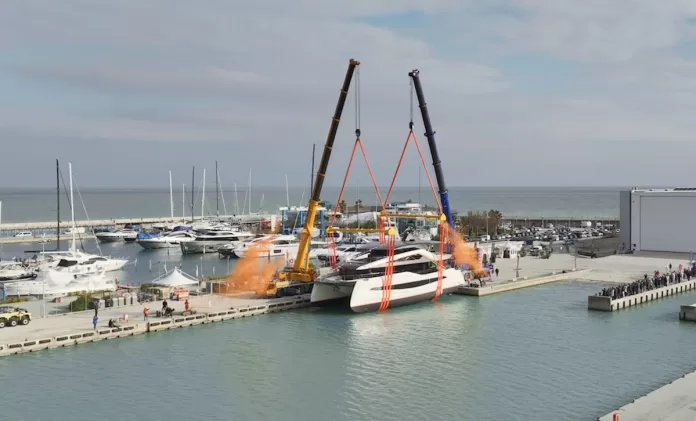The first WiderCat 92 has hit the water.
The 28m composite power catamaran has been designed by Luca Dini Design in partnership with Wider Centro Stile and features two VIP cabins and a twin guest cabin located lower deck. The main deck is dedicated to an owner’s suite with a private foredeck lounge, occupying nearly half of the total space.
Additionally, a four-cabin + owners’ suite layout option is available.
The catamaran is powered using Wider’s advanced serial hybrid propulsion system.
Twin electric motors each deliver 500kW to the thrusters and two 349kW variable speed generators for electrical energy production.
LiFePO4 lithium-iron phosphate batteries are managed by a battery management system.
Generators operate at minimum power consumption, allowing cruising in ZEM (Zero Emission Mode) with a 27-nautical-mile range at 6 knots or a 14-hour autonomy on battery power at anchor.
Self-sufficient
Additionally, 150m2 of solar panels ensure energy self-sufficiency at anchor, with any excess energy stored in the batteries for night-time use.
The Wider serial hybrid propulsion system minimises engine strain, extending maintenance intervals, as well as reducing fuel consumption, noise and vibrations emitted.
“The WiderCat 92 is a collective masterpiece, a synthesis of vision, craftsmanship, and cutting-edge technology.” says Marcello Maggi, head of W-Fin Sarl, the holding company that owns 100% of Wider equity. “Each designer, engineer, and craftsman has poured their passion into this endeavour.
“As we celebrate this achievement, I have full confidence that, just as in our previous milestones, the WiderCat 92 will set a new standard in the industry.”
This is the first craft to be assembled in Wider’s new facility in Fano, Italy.
The shipyard’s production facilities are partially operational and set for completion in 2024. Construction of the portion dedicated to the offices will start soon.
The structure is based on sustainable principles with a design that provides functional efficiencies together with sustainable features.
The roof will be completely covered with solar panels and the facility is expected to be virtually self-sufficient using renewable solar power.



